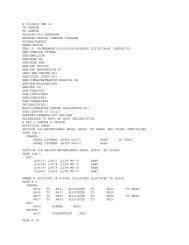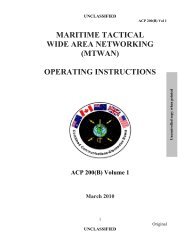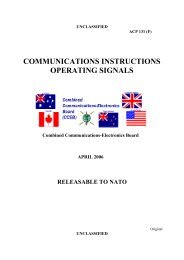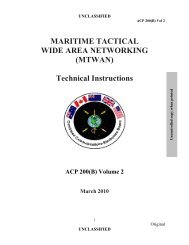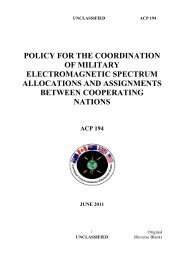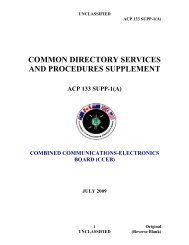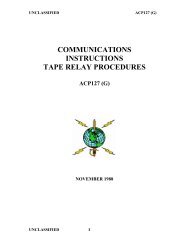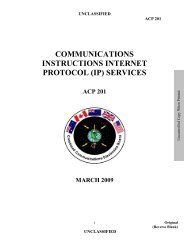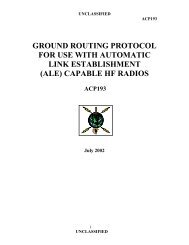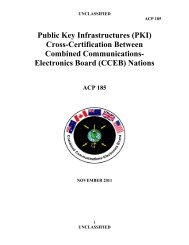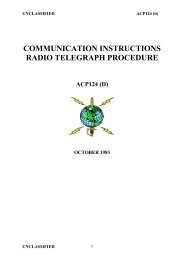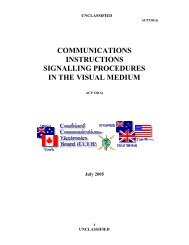ACP 137
ACP 137
ACP 137
Create successful ePaper yourself
Turn your PDF publications into a flip-book with our unique Google optimized e-Paper software.
UNCLASSIFIED<br />
<strong>ACP</strong> <strong>137</strong><br />
INDICATION OF TYPE OF REPLICATION<br />
442. The type of replication being requested will be specified within the Control<br />
Information in the message body text, as follows:<br />
a. An Initial replication type should be expressed as type:initial and in the file<br />
name as init.<br />
b. An Incremental replication type should be expressed as type:incremental and in<br />
the file name as inc.<br />
c. A Verify replication type should be expressed as type:verify and in the file name<br />
as ver.<br />
SCHEMA VERSIONS<br />
443. Successful exchange of directory information over Griffin requires that common<br />
schemas are used by the sending and receiving nation. In order to achieve this, a Schema<br />
Version number may be included in the Control Information. The version number will<br />
comprise two or more characters, an alphabetic followed by one or more numeric characters.<br />
The alphabetic defines the Edition of <strong>ACP</strong> 133 in which the schema is defined, and the<br />
number defines the schema point release in use. Use of the subset schema defined in Chapter<br />
6, Annex A of this specification is given a generic schema version number of C0. The first<br />
ratified version of <strong>ACP</strong> 133(C) will be given the schema version number C1, with future point<br />
releases increasing sequentially.<br />
REPLICATED AREAS<br />
444. A nation may choose to replicate more than one subtree of its DIT to one or more<br />
nations. In this case, an optional Replication Area Number may be specified in the Control<br />
Information. Separate replication areas are useful if the amount of data to be replicated is<br />
large, or the schedule against which updates are required differs markedly (e.g. if PKI<br />
revocation information is to be replicated hourly (or less), whilst other information is to be<br />
replicated weekly).<br />
445. Replicated areas are identified by the keyword area within the Control Information<br />
followed by a number to uniquely identify it. If no replicated area is specified, a default area<br />
of 0 will be assumed (which would indicate a legacy Interim file). Within a replicated area,<br />
sequence numbering of replications will be separately managed. A nation must agree with<br />
another nation that it wishes to use more than one replication area, and also specify the High-<br />
Level DIT entry below which each replicated area will manage entries. Limited overlap of<br />
higher level DIT entries (i.e. Organizational Units) is allowed between replication areas, but<br />
this is to be discouraged. Overlapping of data entries and large areas of the DIT is not<br />
normally allowed, and a receiving nation may discard duplicate entries, which may in turn<br />
lead to verification problems.<br />
4-9<br />
UNCLASSIFIED<br />
Original



